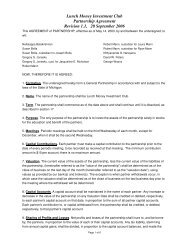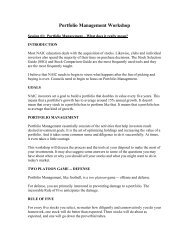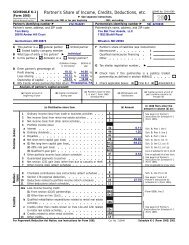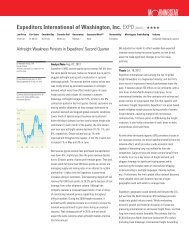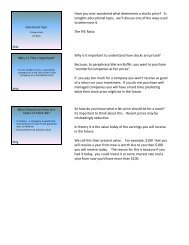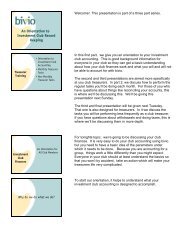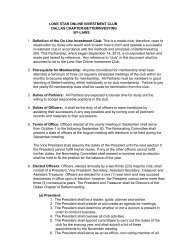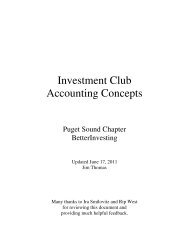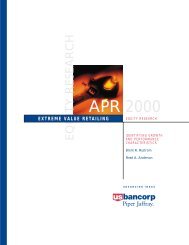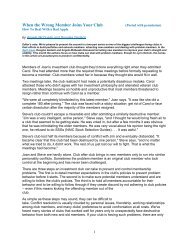Introduction Optional Reading Workshop Content - Bivio
Introduction Optional Reading Workshop Content - Bivio
Introduction Optional Reading Workshop Content - Bivio
Create successful ePaper yourself
Turn your PDF publications into a flip-book with our unique Google optimized e-Paper software.
RAW - LiquidityThis example illustrates that just looking at the value of the currentratio is not always adequate.Assume that Company A has developed a problem on its production line.The items coming out the end of the production line are defective insome way. Some of the items are being held for re-work before they canbe sold. Some defective items have been sold and the customers areholding back payment until the problem is corrected. AccountsReceivable and Inventories are increasing. Cash is decreasing. Thesituation is illustrated in the following table.Data For Current Ratio Example 3Company ACash 0Accounts Receivable 150Inventory 150Other 0Total Current Assets 300Accounts Payable 100Debt Due 0Other 0Total Current Liabilities 100Current Ratio 3The Current Ratio is still 3, but the ability of Company A to pay itsbills has definitely decreased. Does this represent a failure of theCurrent Ratio? Possibly. In practice the company would probably haveslowed down in paying its Accounts payable and/or borrowed some moneyso Debt Due would no longer be zero. Either approach would tend tolower the Current Ratio. Even so, the Current Ratio is not always agood ratio for detecting problems associated with Accounts Receivableand Inventory. We will return to this example when Turnover Ratios arediscussed.PEER REVIEWThe Market Guide Ratio Comparison report dated 01/16/98 shows thatPepsiCo has a Current Ratio of 0.67 and Coca-Cola has a Current Ratioof 0.91 compared to an industry average of 0.84.Part 8 will cover the Quick Ratio.+++++++++++++++++++++++++++++++++++++++++++++++++++++++++++++++++++++++From: glsimms@juno.comSubject: Re: Ratio Analysis <strong>Workshop</strong>-Part 7To: i-club-list@better-investing.orgDate: Mon, 02 Feb 1998 13:34:55 ESTI think that this comment really should be made after part 8 of theTutorial but since Jay has so nicely listed the components of CurrentAssets and Current Liabilities, I will make it here.As I believe we will see in the next tutorial, the Quick ratio makes anattempt to remove an item (inventory) that is more difficult to convertto cash in an effort to show just how much cash the company can come upwith on short notice.Last weekend I bought a programmed workbook that runs you throughsome basic ratio calculation. It is: The Motley Fool InvestmentPage 4



